Xuming He
Omni-Weather: Unified Multimodal Foundation Model for Weather Generation and Understanding
Dec 25, 2025Abstract:Weather modeling requires both accurate prediction and mechanistic interpretation, yet existing methods treat these goals in isolation, separating generation from understanding. To address this gap, we present Omni-Weather, the first multimodal foundation model that unifies weather generation and understanding within a single architecture. Omni-Weather integrates a radar encoder for weather generation tasks, followed by unified processing using a shared self-attention mechanism. Moreover, we construct a Chain-of-Thought dataset for causal reasoning in weather generation, enabling interpretable outputs and improved perceptual quality. Extensive experiments show Omni-Weather achieves state-of-the-art performance in both weather generation and understanding. Our findings further indicate that generative and understanding tasks in the weather domain can mutually enhance each other. Omni-Weather also demonstrates the feasibility and value of unifying weather generation and understanding.
Probing Scientific General Intelligence of LLMs with Scientist-Aligned Workflows
Dec 18, 2025Abstract:Despite advances in scientific AI, a coherent framework for Scientific General Intelligence (SGI)-the ability to autonomously conceive, investigate, and reason across scientific domains-remains lacking. We present an operational SGI definition grounded in the Practical Inquiry Model (PIM: Deliberation, Conception, Action, Perception) and operationalize it via four scientist-aligned tasks: deep research, idea generation, dry/wet experiments, and experimental reasoning. SGI-Bench comprises over 1,000 expert-curated, cross-disciplinary samples inspired by Science's 125 Big Questions, enabling systematic evaluation of state-of-the-art LLMs. Results reveal gaps: low exact match (10--20%) in deep research despite step-level alignment; ideas lacking feasibility and detail; high code executability but low execution result accuracy in dry experiments; low sequence fidelity in wet protocols; and persistent multimodal comparative-reasoning challenges. We further introduce Test-Time Reinforcement Learning (TTRL), which optimizes retrieval-augmented novelty rewards at inference, enhancing hypothesis novelty without reference answer. Together, our PIM-grounded definition, workflow-centric benchmark, and empirical insights establish a foundation for AI systems that genuinely participate in scientific discovery.
GUI-Rise: Structured Reasoning and History Summarization for GUI Navigation
Oct 31, 2025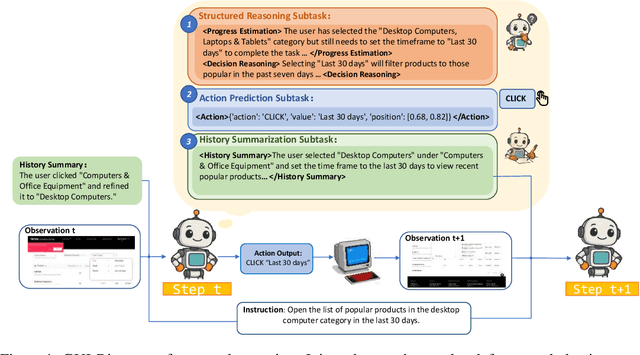
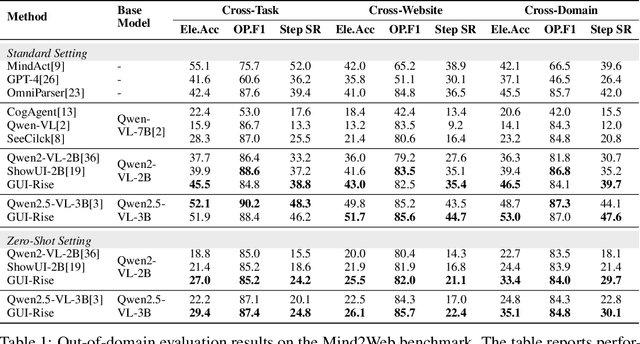
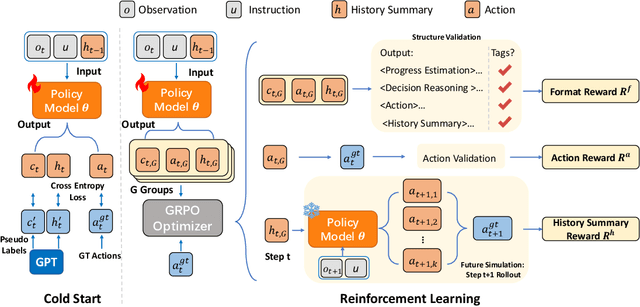
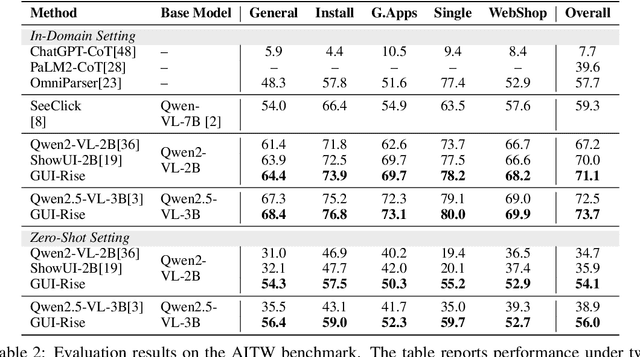
Abstract:While Multimodal Large Language Models (MLLMs) have advanced GUI navigation agents, current approaches face limitations in cross-domain generalization and effective history utilization. We present a reasoning-enhanced framework that systematically integrates structured reasoning, action prediction, and history summarization. The structured reasoning component generates coherent Chain-of-Thought analyses combining progress estimation and decision reasoning, which inform both immediate action predictions and compact history summaries for future steps. Based on this framework, we train a GUI agent, \textbf{GUI-Rise}, through supervised fine-tuning on pseudo-labeled trajectories and reinforcement learning with Group Relative Policy Optimization (GRPO). This framework employs specialized rewards, including a history-aware objective, directly linking summary quality to subsequent action performance. Comprehensive evaluations on standard benchmarks demonstrate state-of-the-art results under identical training data conditions, with particularly strong performance in out-of-domain scenarios. These findings validate our framework's ability to maintain robust reasoning and generalization across diverse GUI navigation tasks. Code is available at https://leon022.github.io/GUI-Rise.
Incremental Human-Object Interaction Detection with Invariant Relation Representation Learning
Oct 30, 2025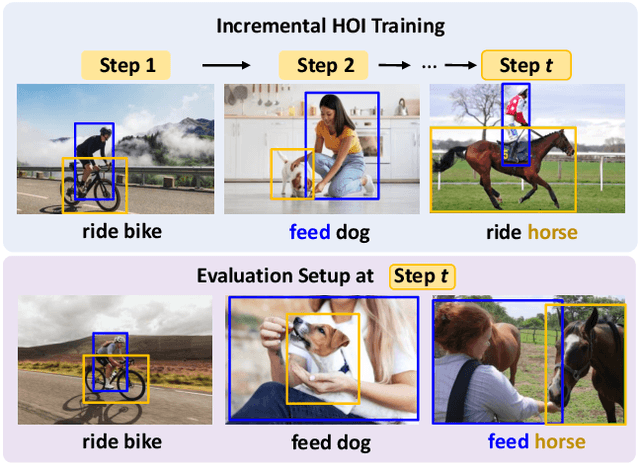



Abstract:In open-world environments, human-object interactions (HOIs) evolve continuously, challenging conventional closed-world HOI detection models. Inspired by humans' ability to progressively acquire knowledge, we explore incremental HOI detection (IHOID) to develop agents capable of discerning human-object relations in such dynamic environments. This setup confronts not only the common issue of catastrophic forgetting in incremental learning but also distinct challenges posed by interaction drift and detecting zero-shot HOI combinations with sequentially arriving data. Therefore, we propose a novel exemplar-free incremental relation distillation (IRD) framework. IRD decouples the learning of objects and relations, and introduces two unique distillation losses for learning invariant relation features across different HOI combinations that share the same relation. Extensive experiments on HICO-DET and V-COCO datasets demonstrate the superiority of our method over state-of-the-art baselines in mitigating forgetting, strengthening robustness against interaction drift, and generalization on zero-shot HOIs. Code is available at \href{https://github.com/weiyana/ContinualHOI}{this HTTP URL}
Pack and Force Your Memory: Long-form and Consistent Video Generation
Oct 02, 2025Abstract:Long-form video generation presents a dual challenge: models must capture long-range dependencies while preventing the error accumulation inherent in autoregressive decoding. To address these challenges, we make two contributions. First, for dynamic context modeling, we propose MemoryPack, a learnable context-retrieval mechanism that leverages both textual and image information as global guidance to jointly model short- and long-term dependencies, achieving minute-level temporal consistency. This design scales gracefully with video length, preserves computational efficiency, and maintains linear complexity. Second, to mitigate error accumulation, we introduce Direct Forcing, an efficient single-step approximating strategy that improves training-inference alignment and thereby curtails error propagation during inference. Together, MemoryPack and Direct Forcing substantially enhance the context consistency and reliability of long-form video generation, advancing the practical usability of autoregressive video models.
RadarQA: Multi-modal Quality Analysis of Weather Radar Forecasts
Aug 17, 2025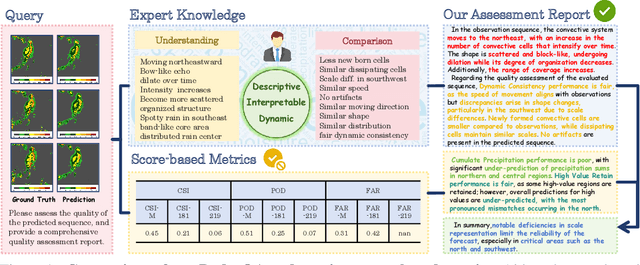
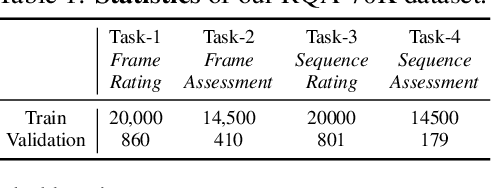


Abstract:Quality analysis of weather forecasts is an essential topic in meteorology. Although traditional score-based evaluation metrics can quantify certain forecast errors, they are still far from meteorological experts in terms of descriptive capability, interpretability, and understanding of dynamic evolution. With the rapid development of Multi-modal Large Language Models (MLLMs), these models become potential tools to overcome the above challenges. In this work, we introduce an MLLM-based weather forecast analysis method, RadarQA, integrating key physical attributes with detailed assessment reports. We introduce a novel and comprehensive task paradigm for multi-modal quality analysis, encompassing both single frame and sequence, under both rating and assessment scenarios. To support training and benchmarking, we design a hybrid annotation pipeline that combines human expert labeling with automated heuristics. With such an annotation method, we construct RQA-70K, a large-scale dataset with varying difficulty levels for radar forecast quality evaluation. We further design a multi-stage training strategy that iteratively improves model performance at each stage. Extensive experiments show that RadarQA outperforms existing general MLLMs across all evaluation settings, highlighting its potential for advancing quality analysis in weather prediction.
Non-Asymptotic Analysis of Online Local Private Learning with SGD
Jul 09, 2025



Abstract:Differentially Private Stochastic Gradient Descent (DP-SGD) has been widely used for solving optimization problems with privacy guarantees in machine learning and statistics. Despite this, a systematic non-asymptotic convergence analysis for DP-SGD, particularly in the context of online problems and local differential privacy (LDP) models, remains largely elusive. Existing non-asymptotic analyses have focused on non-private optimization methods, and hence are not applicable to privacy-preserving optimization problems. This work initiates the analysis to bridge this gap and opens the door to non-asymptotic convergence analysis of private optimization problems. A general framework is investigated for the online LDP model in stochastic optimization problems. We assume that sensitive information from individuals is collected sequentially and aim to estimate, in real-time, a static parameter that pertains to the population of interest. Most importantly, we conduct a comprehensive non-asymptotic convergence analysis of the proposed estimators in finite-sample situations, which gives their users practical guidelines regarding the effect of various hyperparameters, such as step size, parameter dimensions, and privacy budgets, on convergence rates. Our proposed estimators are validated in the theoretical and practical realms by rigorous mathematical derivations and carefully constructed numerical experiments.
Scientists' First Exam: Probing Cognitive Abilities of MLLM via Perception, Understanding, and Reasoning
Jun 12, 2025Abstract:Scientific discoveries increasingly rely on complex multimodal reasoning based on information-intensive scientific data and domain-specific expertise. Empowered by expert-level scientific benchmarks, scientific Multimodal Large Language Models (MLLMs) hold the potential to significantly enhance this discovery process in realistic workflows. However, current scientific benchmarks mostly focus on evaluating the knowledge understanding capabilities of MLLMs, leading to an inadequate assessment of their perception and reasoning abilities. To address this gap, we present the Scientists' First Exam (SFE) benchmark, designed to evaluate the scientific cognitive capacities of MLLMs through three interconnected levels: scientific signal perception, scientific attribute understanding, scientific comparative reasoning. Specifically, SFE comprises 830 expert-verified VQA pairs across three question types, spanning 66 multimodal tasks across five high-value disciplines. Extensive experiments reveal that current state-of-the-art GPT-o3 and InternVL-3 achieve only 34.08% and 26.52% on SFE, highlighting significant room for MLLMs to improve in scientific realms. We hope the insights obtained in SFE will facilitate further developments in AI-enhanced scientific discoveries.
OmniEarth-Bench: Towards Holistic Evaluation of Earth's Six Spheres and Cross-Spheres Interactions with Multimodal Observational Earth Data
May 29, 2025Abstract:Existing benchmarks for Earth science multimodal learning exhibit critical limitations in systematic coverage of geosystem components and cross-sphere interactions, often constrained to isolated subsystems (only in Human-activities sphere or atmosphere) with limited evaluation dimensions (less than 16 tasks). To address these gaps, we introduce OmniEarth-Bench, the first comprehensive multimodal benchmark spanning all six Earth science spheres (atmosphere, lithosphere, Oceansphere, cryosphere, biosphere and Human-activities sphere) and cross-spheres with one hundred expert-curated evaluation dimensions. Leveraging observational data from satellite sensors and in-situ measurements, OmniEarth-Bench integrates 29,779 annotations across four tiers: perception, general reasoning, scientific knowledge reasoning and chain-of-thought (CoT) reasoning. This involves the efforts of 2-5 experts per sphere to establish authoritative evaluation dimensions and curate relevant observational datasets, 40 crowd-sourcing annotators to assist experts for annotations, and finally, OmniEarth-Bench is validated via hybrid expert-crowd workflows to reduce label ambiguity. Experiments on 9 state-of-the-art MLLMs reveal that even the most advanced models struggle with our benchmarks, where none of them reach 35\% accuracy. Especially, in some cross-spheres tasks, the performance of leading models like GPT-4o drops to 0.0\%. OmniEarth-Bench sets a new standard for geosystem-aware AI, advancing both scientific discovery and practical applications in environmental monitoring and disaster prediction. The dataset, source code, and trained models were released.
Freeze and Cluster: A Simple Baseline for Rehearsal-Free Continual Category Discovery
Mar 12, 2025Abstract:This paper addresses the problem of Rehearsal-Free Continual Category Discovery (RF-CCD), which focuses on continuously identifying novel class by leveraging knowledge from labeled data. Existing methods typically train from scratch, overlooking the potential of base models, and often resort to data storage to prevent forgetting. Moreover, because RF-CCD encompasses both continual learning and novel class discovery, previous approaches have struggled to effectively integrate advanced techniques from these fields, resulting in less convincing comparisons and failing to reveal the unique challenges posed by RF-CCD. To address these challenges, we lead the way in integrating advancements from both domains and conducting extensive experiments and analyses. Our findings demonstrate that this integration can achieve state-of-the-art results, leading to the conclusion that in the presence of pre-trained models, the representation does not improve and may even degrade with the introduction of unlabeled data. To mitigate representation degradation, we propose a straightforward yet highly effective baseline method. This method first utilizes prior knowledge of known categories to estimate the number of novel classes. It then acquires representations using a model specifically trained on the base classes, generates high-quality pseudo-labels through k-means clustering, and trains only the classifier layer. We validate our conclusions and methods by conducting extensive experiments across multiple benchmarks, including the Stanford Cars, CUB, iNat, and Tiny-ImageNet datasets. The results clearly illustrate our findings, demonstrate the effectiveness of our baseline, and pave the way for future advancements in RF-CCD.
 Add to Chrome
Add to Chrome Add to Firefox
Add to Firefox Add to Edge
Add to Edge